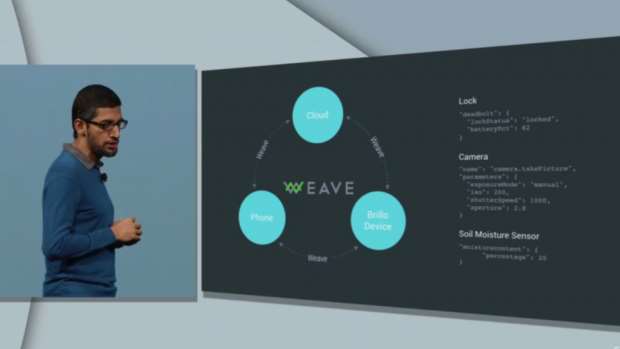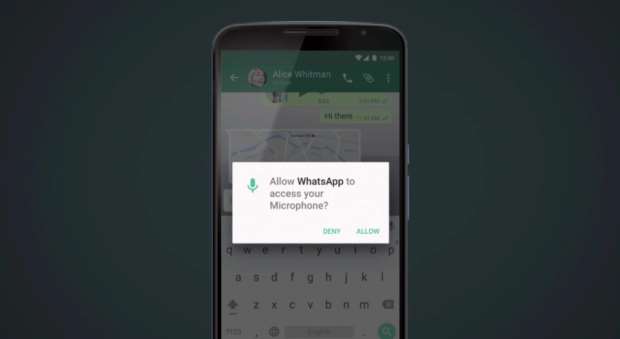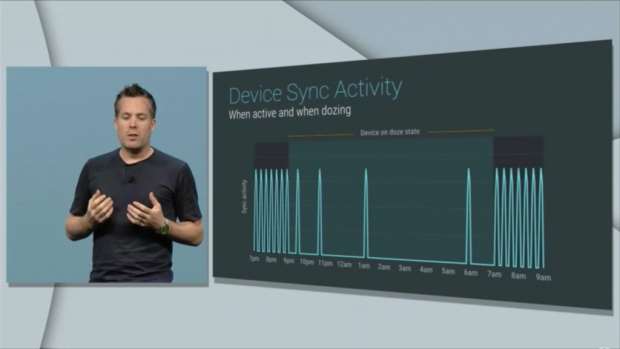Internet of Things: Google reveal Project Brillo and Weave
Google has revealed steps to unify the sprawling Internet of Things (IoT) using Brillo OS and Weave communications language.
Teams from Nest, Android and Chrome OS have been working together to create a comprehensive system that links integrated devices in the home.
Name-dropping the Nest Thermostat and Nest Protect CO protector, Sundar Pichai claimed that Google are putting forward an “end-to-end solution” for the IoT. This is broken down into three parts: the underlying operating system, the communications layer and an elegant operating system for users.
Project Brillo will be the underlying OS. Brillo is “derived” from Android but “polished” to the lower levels. Because its based on Android, it has broad silicon support, is easy to secure and minimal system requirements. It also supports Wi-Fi and Bluetooth, which is very handy.

Weave is the communications layer between the cloud, your smartphone and Brillo devices. Essentially, it lets these parts of the IoT talk to each other. Weave is also cross platform.
Android devices will auto-detect both Brillo and Weave. Brillo will launch Q3 2015 and Weave will launch Q4 2015.
Android Wear 5.1.1
After making some sly digs at Apple Watch for having a “lack of choice” in terms of design, Android Wear director David Singleton went on to highlight some of the new features of Android Wear update 5.1.1.
While the crowd applauded the new features of emoji recognition, hands-free interaction and always-on screens, none of these features are actually very new to Android Wear at all. The latest update came out weeks before I/O.

However, Singleton did highlight upcoming Android Wear Apps, and a snazzy voice activation feature for Uber's Android Wear app. He also revealed that Android Wear already has 4,000 apps available for download. A large number, but with Apple Watch already growing in popularity, it will need to grow faster to stay ahead of the competition.
Android M gives you more control over your app's permissions
With Android M Google is looking to work on improving user experience within the mobile environment after the Android 5 Lollipop overhaul. This doesn't just mean quashing bugs, but altering the fundamental ways in which Android works on a developer level.
Central to this idea is streamlining how users interact with apps. In Android M, instead of Apps hassling you for permissions upon installation, it only requires you to authorise the services when you actually use them. One example given was WhatsApp's microphone support. Here it was automatically turned off upon installation, and when you decide to use a voice note for the first time it kicks in and asks if you'd like to give WhatsApp permission to use the microphone.

In each Android M-ready app you can pick and choose what permissions each app has. Any legacy apps, i.e ones made for Lollipop or earlier, will operate as they always have, meaning no headaches installing older applications.
Google offers first glimpse of Android Pay
Google reveals the Android Pay system that enables users able to authorise payments through fingerprints on Android M. Android Pay works with KitKat or later devices and is, according to Dave Burke, about “simplicity, security, and choice."
Android Pay uses NFC and Host Card Emulation, works with 700,000 stores in the US, including McDonalds Uber. It also works in-app for in-app purchases.
"The same partnership model that fueled Android's growth" will help Android Pay, claims Burke.
Android Pay is an open platform, so can be activated either through Google or your bank's app. According to the presentation, Google are working with American Express, Visa, Discover and Mastercard.
Interestingly, Android M's inbuilt fingerprint sensor will allow users to authorise payments using fingerprints. The news comes as an onslaught against Apple Pay, and is a clear attempt to grab hold of the burgeoning mobile payment service.
Android M's improved power management and charging
Android M introduces Doze, a new power management system to get the most out of your Android device. The new system uses motion detection to monitor when your tablet or smartphone is unattended, and then puts it into a deeper, energy-saving sleep than the normal standby mode.
Although Google say it'll take slightly longer to wake up, alarms and chat requests will function as normal. What's more Google have already put the new system to the test - and the results are impressive. A Nexus 9 loaded with Android M lasted twice as long on standby as one with Lollipop.

Android M also has future-proof support for USB Type-C - as seen on Apple's latest MacBook. Google believe it can help charge devices at up to 3.5 times the speed, and like Apple's Lightning connector, it also works any way up. USB Type C's versatility means it can be used to charge, transfer data or and much more - so Android M now allows you to choose select the function when connect any other USB Type C device. You'll even be able to use your Android M smartphone to charge other devices.
Android M app Streamlining
Another feature of Android M is streamlining how apps interact with one another. Instead of opening Chrome or bundling in a custom browser for an in-app web browsing experience, Google has developed a service known as Chrome Custom Tabs.
Click a web link inside an app and Chrome Custom Tabs takes over, seamlessly layering in a Chrome tab with the same look and feel as the app you came from. This ensures users have lightweight apps, and all their login, browser history and site preferences are automatically carried across.
Android M's other streamlining initiative is its ability to link from app to app. With a new piece of code dropped into Android M, you'll see far less of those irritating “which app do you want to open this in?” messages. Instead, Android M will just know the best app to open with.
This article originally appeared at pcpro.co.uk




.jpg&h=142&w=230&c=1&s=1)


.png&h=142&w=230&c=1&s=1)




.jpg&w=100&c=1&s=0)
_(8).jpg&w=100&c=1&s=0)










